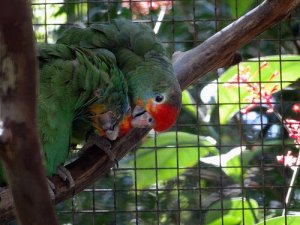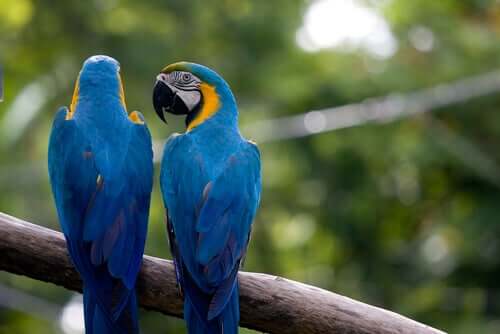The Reproduction of Domestic Parrots


Written and verified by the lawyer Francisco María García
Getting two parrots to reproduce in a cage isn’t impossible. However, this chore requires a good understanding of the mating process and the sexual behavior of this species. In other words, the reproduction of domestic parrots has its complexities.
In captivity, parrot owners have the responsibility of creating the right conditions for mating. Any disharmonious element could ruin your plans for successful reproduction. Even once parrots are born, there are guidelines to which you must adhere.
If you are diligent and careful, you may manage to get many baby birds from the same parents. In the following article, we’ll tell you all you need to know about reproduction in domestic parrots.
What stages does the reproduction of domestic parrots involve?
Mating begins as soon as both animals approach the ritual. In a natural setting, this event involves the female parrot choosing a male to be her partner.

After that comes the period of nesting the eggs and then the birth of the young. Environmental factors, the building of the nest, and the compatibility of the birds are elements that you must keep in mind.
And the final stage of the process is the independence of the offspring. At each and every stage, owners must be actively watchful and vigilant to make sure everything follows its natural course. The objective is not to allow the cage to interrupt the life cycle of these feathered pets.
Courtship: The beginning of the cycle
Without courtship, it’s unlikely for anything more to take place between domestic parrots… And the same is true for those in the wild. Many owners tend to confuse this act with strange and even hostile behavior on the male’s part. But, as unusual as it may appear, it’s best not to interfere.
This instinctive activity consists of fluttering of the wings, dancing, and progressive approaches. If the two birds click, the male tends to slide its beak gently over the head of the female. Another good sign to look for is when the male gives the female food and she accepts it.
Of course, each species has its own rituals and responses. In any case, courtship gives the female the opportunity to choose a male, gain confidence, and form bonds. Some females take this process more seriously than others and are very picky. So, there won’t always be love at first sight.
The right conditions for mating
The success of courtship and the act of reproduction depends on some factors that owners can contribute to. First of all, the cage should be spacious enough for both birds to carry on naturally.
Another fundamental issue is food. For two domestic parrots to mate, it’s fundamental that they both be well fed. They should enjoy a varied and balanced diet that consists of more than just seeds. Before attempting to bring the two birds together, you need to be sure that neither the male or the female is sick or obese.
What’s more, you need to make sure you have two specimens that belong to the same parrot species. If no sexual compatibility exists, then any efforts you make will be pointless.
Parrot eggs
Parrots can lay between two and six eggs, which can vary depending on the species. For example, the Australian parakeet generally lays between four and six eggs. And those that inhabit the Amazon region tend to produce no more than four eggs at a time.
After that, the eggs have an incubation period that lasts between 20 and 25 days. In general, females take on the task of incubating their eggs. However, there are some species of domestic parrots that share this responsibility.
The incubation period and the number of babies that can come from one litter indicates that the same pair of birds can provide a great number of offspring. Just the same, we should always maintain the same pair, as parrots are monogamous.

The nest: the key to the successful reproduction of domestic parrots
The nests of domestic parrots are very particular–they should be vertical and higher than they are wide. It’s best for owners to build the nest, making it as similar as possible to a natural one.
It’s important to keep in mind that these birds can dig their own nests in trees. Therefore, it’s best to construct a wooden prototype that’s at least 16 inches long and 8 inches wide. You should leave a hole on one side and you can also place a removable lid on the top.
The idea is to place this box-shaped nest inside the cage even before mating takes place.
Offspring
When an egg hatches, the young are born defenseless and without feathers. This state of helplessness lasts for approximately a month and a half. Therefore, they require the protection of their parents. And this protection is vital when it comes to avoiding infectious disease and preparing them for independence.
One last warning: Once this period of protection is over, it’s best to separate the new litter from their parents. After this, the reproductive cycle of domestic parrots begins again and continues to repeat until one of the two parents dies.
Source of main image: Rodrigo Soldon
Getting two parrots to reproduce in a cage isn’t impossible. However, this chore requires a good understanding of the mating process and the sexual behavior of this species. In other words, the reproduction of domestic parrots has its complexities.
In captivity, parrot owners have the responsibility of creating the right conditions for mating. Any disharmonious element could ruin your plans for successful reproduction. Even once parrots are born, there are guidelines to which you must adhere.
If you are diligent and careful, you may manage to get many baby birds from the same parents. In the following article, we’ll tell you all you need to know about reproduction in domestic parrots.
What stages does the reproduction of domestic parrots involve?
Mating begins as soon as both animals approach the ritual. In a natural setting, this event involves the female parrot choosing a male to be her partner.

After that comes the period of nesting the eggs and then the birth of the young. Environmental factors, the building of the nest, and the compatibility of the birds are elements that you must keep in mind.
And the final stage of the process is the independence of the offspring. At each and every stage, owners must be actively watchful and vigilant to make sure everything follows its natural course. The objective is not to allow the cage to interrupt the life cycle of these feathered pets.
Courtship: The beginning of the cycle
Without courtship, it’s unlikely for anything more to take place between domestic parrots… And the same is true for those in the wild. Many owners tend to confuse this act with strange and even hostile behavior on the male’s part. But, as unusual as it may appear, it’s best not to interfere.
This instinctive activity consists of fluttering of the wings, dancing, and progressive approaches. If the two birds click, the male tends to slide its beak gently over the head of the female. Another good sign to look for is when the male gives the female food and she accepts it.
Of course, each species has its own rituals and responses. In any case, courtship gives the female the opportunity to choose a male, gain confidence, and form bonds. Some females take this process more seriously than others and are very picky. So, there won’t always be love at first sight.
The right conditions for mating
The success of courtship and the act of reproduction depends on some factors that owners can contribute to. First of all, the cage should be spacious enough for both birds to carry on naturally.
Another fundamental issue is food. For two domestic parrots to mate, it’s fundamental that they both be well fed. They should enjoy a varied and balanced diet that consists of more than just seeds. Before attempting to bring the two birds together, you need to be sure that neither the male or the female is sick or obese.
What’s more, you need to make sure you have two specimens that belong to the same parrot species. If no sexual compatibility exists, then any efforts you make will be pointless.
Parrot eggs
Parrots can lay between two and six eggs, which can vary depending on the species. For example, the Australian parakeet generally lays between four and six eggs. And those that inhabit the Amazon region tend to produce no more than four eggs at a time.
After that, the eggs have an incubation period that lasts between 20 and 25 days. In general, females take on the task of incubating their eggs. However, there are some species of domestic parrots that share this responsibility.
The incubation period and the number of babies that can come from one litter indicates that the same pair of birds can provide a great number of offspring. Just the same, we should always maintain the same pair, as parrots are monogamous.

The nest: the key to the successful reproduction of domestic parrots
The nests of domestic parrots are very particular–they should be vertical and higher than they are wide. It’s best for owners to build the nest, making it as similar as possible to a natural one.
It’s important to keep in mind that these birds can dig their own nests in trees. Therefore, it’s best to construct a wooden prototype that’s at least 16 inches long and 8 inches wide. You should leave a hole on one side and you can also place a removable lid on the top.
The idea is to place this box-shaped nest inside the cage even before mating takes place.
Offspring
When an egg hatches, the young are born defenseless and without feathers. This state of helplessness lasts for approximately a month and a half. Therefore, they require the protection of their parents. And this protection is vital when it comes to avoiding infectious disease and preparing them for independence.
One last warning: Once this period of protection is over, it’s best to separate the new litter from their parents. After this, the reproductive cycle of domestic parrots begins again and continues to repeat until one of the two parents dies.
Source of main image: Rodrigo Soldon
All cited sources were thoroughly reviewed by our team to ensure their quality, reliability, currency, and validity. The bibliography of this article was considered reliable and of academic or scientific accuracy.
- Álvarez, G. G., Azúa, R. V., Solano, C. T., & Gómez, S. R. R. (2005). Manejo en cautiverio de psitácidos utilizados como aves de ornato y compañía. Revista de la Asociación de Médicos Veterinarios Especialistas en Pequeñas Especies, 16(1), 5-17.
This text is provided for informational purposes only and does not replace consultation with a professional. If in doubt, consult your specialist.








